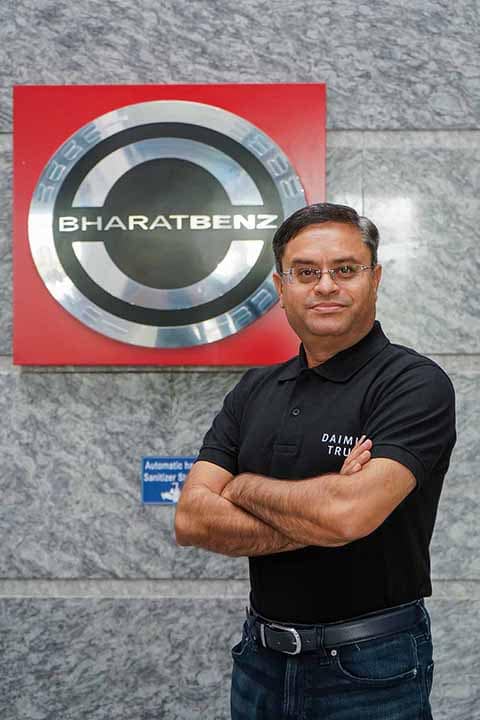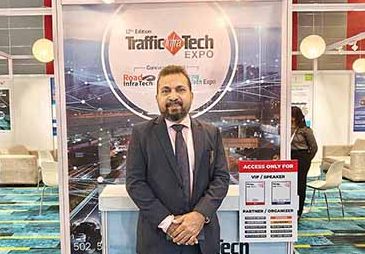In an upfront interaction, Satyakam Arya, Chairman of CII, Tamil Nadu State Council and MD & CEO at Daimler India Commercial Vehicles speaks to Ashish Bhatia on Tamil Nadu finding industry favour and contributing to India’s economic growth rate. He also hails a successful decade of operations in India.
- Where do you see the demand revival coming from?
A: The market slowed down because of the slowing GDP growth, and that’s now coming back on its feet. This is leading to new demand and the movement of freight, and therefore demand for trucks. The second important aspect is, that in 2019 itself, the market had started to slow down. First due to the transition to BSVI, and then due to Covid-19. So it’s been three years which is a very long period of fleets not being replaced. Now, when GDP is relatively growing healthier, there is an increased demand for the movement of goods. All the fleet owners are coming back and buying new trucks. This is one major dimension which is rolling out in front of us.
The second dimension, which we will see, going forward, and will impact the CV industry is the scrappage policy. The policy has been rolled out but as the infrastructure grows, this includes the scrappage centres and the testing centres, it will have a good impetus on the demand by way of fleet replacement. The third important dimension is regulations. After transition to Bharat Stage VI, we are gearing up for the OBD II, safety regulations are lined up and these will also influence the industry going forward.
The other standalone dimension is the infrastructure as a whole in itself. We have seen the government investing aggressively in infrastructure. Whether it’s the express highways or the multi- modal logistics parks. These will have an impact in the medium- to long-term. People will prefer trucks which can do higher speeds which translates to higher horsepower for a better Turn Around Time (TAT), and lower Total Cost of Operations (TCO). It will mean that the entire product portfolio will shift in this direction. With multi- modal logistics parks coming up across the country, we will see a sharper differentiation between light-duty, medium-duty and heavy-duty trucks which at present is not at par with global benchmarks.
The next big impact as a ripple effect will be the logistics cost in India, estimated to be at 13-14 per cent of the GDP. This should settle somewhere in the region of eight to 10 per cent which would be at par with Germany, for example. These are some of the factors which are influencing how the industry as a whole is structured.
- How do you look at the defining trends like turning to a gas-based economy with a shift to CNG for example?
A : There is an uptick in people adopting gas. We all know the reasons behind it. There is an increase in the price of diesel and there is parity with gas. So even if the product may not deliver the same horsepower or torque, people are ready to compromise to bring down their running costs. I believe India is charting its way to transition away from diesel or gasoline. It’s a mix of blended fuels, it’s a mix of gas whether it’s Compressed Natural Gas (CNG) or Liquefied Nitrogen Gas (LNG) and eventually, it will be electric as well as hydrogen. In the mid-term, I see India taking these directions but over the long-term, I see many of these fuel options as transitory options. This means, eventually, in two or three decades, we will settle down with the final solution which could be a mix of electric and hydrogen.
- Tell us about the long-standing focus on driver ergonomics and occupant and pedestrian safety. How have plant safety standards evolved and how are these redefining the ecosystem?
A: Safety is deeply ingrained in our value system. Whether it’s our manufacturing plant, our operations or our products we have always been the best on the bench and defined how the market moves. As one example which is a testimony, when we were entering this market just 10 years ago, we decided we will only have the factory-fitted, well-engineered steel cabins. I remember, at that time, the entire CV market had only a ~ 20 per cent penetration on the front. 80 per cent of the market constituted the cowl trucks which then go to a body-builder to be fitted with a wooden cabin. I think we both know, how unsafe that product is when it rolls out of the factory. It’s a half-built cabin.
I struggle with the fact that India is the only market now offering a Bharat Stage VI emission compliant product, at par with global benchmarks or a notch behind, but when it comes to safety, we have a lot of ground to cover. Even now, an estimated 40 per cent of the trucks sold in this market are cowl. It’s high time that the government should act on it. The entire society and the industry act on it and say we do not deliver what we consider unsafe even if it meets the regulations. We must go above and beyond. I believe, compliance is about doing things right but integrity is about doing the right thing. This has always been a firm belief and going forward we will continue to.
- You said it’s just been 10 years since you entered the Indian market. What have been the learnings of the decade gone by and what are the major focus areas for the next decade?
A: There are a lot of learnings and no two ways about it. I believe, we have successfully delivered on our promise on many fronts. We began by promising that we will come out with products that are ahead of the market. They are more fuel-efficient, leaders in TCO, and they will set new safety benchmarks. We have delivered on each of these fronts. To give you an example, whenever I meet my customers, they tell me, that if a fleet owner has a BharatBenz and some other brands, the driver has a natural inclination to drive the former. They don’t want to drive another brand. Even while away on a vacation, they make sure that they get the BharatBenz key back on returning. That’s their way of expressing their love for the product.
With this focus on technology leadership, we’ve also transformed the CV market in a lot of ways. We will continue to strive for this. It is ingrained in BharatBenz and we will never change course. So what will change? We also supply to 50 markets worldwide. Going forward, the focus will be to go deeper into these markets. So while we develop products for India, we will also continue to explore newer markets and continue to solidify our position as well where exports are concerned. On the future technology front, we are working internally on fronts like Mobility-as-a-Service (MaaS) and preparing ourselves for what lies ahead. To sump, it will mean different fuel options, and also help our push to offer mobility as a solution rather than just a product itself.
- How difficult is it to convince the Indian customer to look beyond acquisition costs to costs over an entire life cycle when selling mobility as a solution?
A: It is the case with a lot of them but not everyone. When we entered the market, we came in with the Total Cost of Operation (TCO) logic. We use to sit across from the customer, understand their entire operation and calculate the cost, for instance, over five years. The idea is to explain, that if you buy a BharatBenz, with a slightly higher price than the competition, you will save a lot more in a very short period. This is attributed to better fuel efficiency, better TAT, and also higher safety. We have concluded that customers believe in this ideology. Customers today pro-actively ask for solutions to attain a better TCO. In one exercise, we looked at our entire customer portfolio and found that, on average, someone who buys a BharatBenz, for the first time, buys two trucks. The second time, the same customer buys eight trucks. The third time they buy 22 trucks on average. This tells you that the Indian customers are very cost-savvy but they also understand what gets delivered as a whole over the long term.
- You’ve repeatedly quoted the phrase, the more you sweat in peace the less you bleed in war. How does one translate it into business strategy?
A: I very distinctly remember I was once on my way to the plant here at Oragadam. This was just after the first lock down. We all had apprehensions at that point and time about stepping out of the work from home culture and how it would play out. We did everything possible in our hands to ensure the safety of our people. It was then that I read this Malaysian proverb, I found it to closely correlate with the situation faced. Peace is akin to markets being closed so there was less to sell and hence deemed a peaceful time. I decided we must not let our efforts down and we must continue with our mid-to-long-term strategy and not waver from it. It was the time to do more so that when the crisis is over you find yourselves better prepared. I am happy we could go through with it successfully over the past two years.
- How do you see Tamil Nadu growing in stature beyond current levels to draw investment and find favour from the industry as a potential micro-market?
A: I have a very strong belief and confidence on two fronts. As Covid19 subsides, India will emerge with the highest economic growth rate, globally. Within India, Tamil Nadu will be the number one state. We already rank second in terms of GDP after Maharashtra and with all the efforts of the government and the entire industry is putting, Tamil Nadu will be a major attraction for multiple sectors of the economy as far as new investments are concerned. We’ve seen some of these announcements coming in; we’ve seen our honourable Chief Minister leading with participation and industry dialogues to understand their needs, and committing to them, the desired ecosystem to deliver.










Leave a Reply